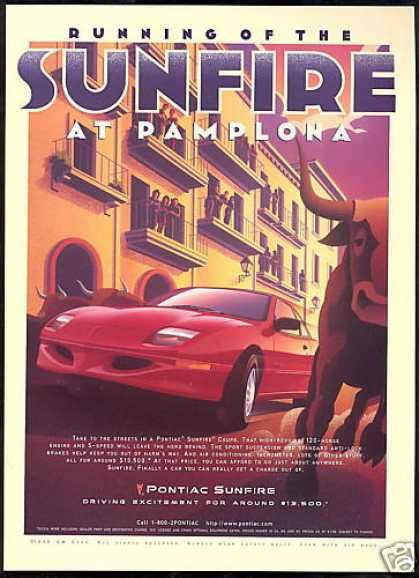Source: AutomotorPro.com – Some Automakers Think that Advertising with Hispanics is like going to Pamplona and Running in front of the Toro
Some automakers think that advertising with Hispanics is like going to Pamplona and running in front of the Toro
Car Industry News
Written by Enrique Kogan and Marco Carvajal
For many of the 500 largest companies in Standard & Poor’s, facing the Hispanic market is like facing a Toro in Pamplona, so one must have the guts to do it, but not everyone is encouraged.
Some automakers operating in the United States think that Hispanics are just a fleeting flurry, which at some point will assimilate, as several of these automakers do not spend a penny on the Hispanic market, one of the most lucrative in the world. I hope it won’t be too late when these automakers understand that the hispanic market not only is very important, but is actually growing at a very large ratio. Some automakers understand how important is to enter the hispanic market now, early on time, and they are investing and setting up a strong base with hispanics, and later it will be hard to compete with such automakers that are starting to be very popular with U.S. hispanics.
For many of the 500 largest companies in Standard & Poor’s, facing the Hispanic market is like facing a Toro in Pamplona, so one must have the guts to do it, but not everyone is encouraged.
According to the Association of Hispanic Advertising Agencies (AHAA), some of the top 500 advertisers in the United States, who use alternative media for minorities, spend between 5 and 6 % of their budgets when targeting Hispanics.
These expenses are on average 10% lower than the actual demographic presence of Hispanic consumers in the United States market.
There are cases like that of General Motors with a budget in the general market of 3.5 trillion dollars, and only slightly less than 50 million for the Hispanic market, which is lost being announced between soap operas.
Twenty years ago, you ask a woman who was leaving her job, what soap opera she was watching, she would answer, a soap opera of the poor girl who married the rich young man. Today you ask a woman who leaves her work, which soap opera she likes, and she will respond: “The only one I know is mine.”
Today the internet, bloggers and personalized and specialized websites have taken the lives of Hispanic workers and young people, leaving television one step behind.
Television is becoming more popular for sectors of lower economic power, many of them living on the unemployment check. And this low economic sector who watch soap operas, usually does not qualify for a new car, so automakers need to be smarter on how to reach Hispanics who are looking for their new car.
Nowadays, many companies plan insufficiently and do not do a good job running campaigns for the Hispanic market, especially because sometimes they don’t understand this market. Then after their non successful campaigns, they document their failures online, and other companies become extremely skeptical of the mistakes of others, about raising budgets for Hispanic marketing or not. But the market responds well to marketing, advertisers just need to understand how to run in front of this U.S. hispanic Toro.
There were and there are cases of mainstream advertising agencies that were enthusiastic about the Hispanic market and went out to buy as much of the hispanic media as they could, with the joy of these minority media that have tried to develop without support from large Hispanic agencies middle man. But unfortunately, some of the car manufacturers later decided to transfer the Bull, without the tail, to a Hispanic agency later.
Hispanic agencies or not?
Here comes one of the problems. When a Hispanic advertising agency takes over an account of a mainstream agency that is advertising in the Hispanic market, the first thing it does is cut off most of the smaller media, and put all the eggs in one basket, with the consequent anger of the smaller media, accustomed to strong sponsorship and quick payment from advertising agencies.
So, is it better to have a mainstream agency without knowledge of the Hispanic market to take the reins, or that a Hispanic agency would have control, leaving behind the aid to the most needy media that are giving growth to small businesses?
Mostly, Hispanic agencies are only guided by media that are safe for them, leaving out the necessary support for the growth of smaller media. So, what do we have: Is it better to have a Hispanic agency or not?
A Hispanic blogger who was right with his sayings, said: A common mistake is when companies choose a marketing agency without multicultural and intercultural capabilities to work on a specifically Hispanic marketing initiative. This is similar to choosing a table saw to loosen a screw.
For my 35 years in the market I have seen and experienced these mistakes, seeing ads that seemed to be made for Hindus, rather than for Hispanics.
And that is where mainstream agencies fail, to know how to choose, since not all Hispanic agencies are good, and not all of them, or almost all of them, do not support the smaller media, so that they can have a growth in the community.
Many advertisers got tired of these problems and resort today to creating their own Hispanic department in the agency, to have more control.
Yet, as the song “La Vida sigue igual” says, and these Hispanic departments within large global agencies, they do the same thing as Hispanic agencies, because they are looking for the big media, and they stop supporting the little ones that depend of them for their growth.
And it all ends quickly, because both Hispanic agencies and these Hispanic departments within large agencies have never stay for a long time with an account, except for rare cases like that of Ford with Zuby, which has already been purchased by a mainstream agency.
There are Hispanic agencies that look like they come out of a horror movie. Because there must be Zombies inside them. No one answers the phone. No one answers email. No one answers a letter. No one answers a voice message or whatsapp. No one answers if they send you a messenger pigeon or make smoke signals from the window. Like the Yeti, we know it exists or we think we know it, but no one saw it.
In the 1980s, a Hispanic agency received the largest telephone bill. This company decided to send the check for the entire year, to avoid many contacts and monthly payments. The owner of the agency thought: I already have all the money for the work of the agency for the whole year? But he also thought: With this money can I go to Mexico and enjoy? They imagine what happened. According to those who know him, he returned after 10 years, and opened another agency.
As many industry executives and marketing experts believe, Hispanic consumers could be the automotive industry’s top growth driver for the next 20 to 30 years.
But many of the auto executives do not see it that way, partly because for them speaking Spanish is like speaking Chinese, because they do not understand it, nor do they care to understand it.
Who really supports the market?
Maybe we can get Nissan and Toyota off this list. Toyota has prevailed decades ago in the United States and has always had a presence in the Hispanic market. The Japanese automaker has created a dedicated corporate department: the “Hispanic Business Strategy Group” to lead Toyota and Lexus, greater prominence among Hispanic consumers in the United States.
Nissan, with its president José Muñoz, recently helped some of Mexico’s most successful retailers open dealerships in major US cities to improve brand ties with Hispanic consumers, and is a success as Honda shifted to second place in the Spanish popularity and if it continues that path then in a few years, Nissan could move to take over Toyota’s leadership with Hispanics. Let’s not forget that 60% of the Hispanic market is Mexican and Nissan is a broad leader in Mexico. And that perception of leadership in your country, helps the taste of the new immigrant.
Honda has been a strong but conservative brand with its ads, has lost power and taste among Hispanics, and was relegated to third place with Ford and Chevrolet, Kia behind. The Japanese automaker has struggled with its brand personality and Acura sedans that are no longer hot models. Even worse, Honda instead of raising the budget to Hispanics, cut it by almost 15%. As for them we are already irrelevant….Honda be careful with the Toro, don’t let the hispanic market run away.
There was a time when it was said: Honda was needed as bread. Today it is like the carbohydrate, Hispanics are beginning to abstain from the boring brand, which has recently had to take fast models (Type R) to avoid keep losing the hispanic market.
But they say, the one who leaves a mark, does not return so fast, and Honda has continued to decrease and will continue this way until they change their public relations team and advertising, which are always directed at the same media.
The Kia case is different, as it manufactures an average of 20% fewer cars than its older brother Hyundai, but has better penetration among Hispanics. His good public relations agency works a lot with the new Hispanic, the bloggers and the internet, and this has led Kia to surpass Hyundai. Of course, also its models are flashy and tasteful.
Ford’s public relations department is more active with Hispanics than General Motors, which has almost no presence. Even GM and unlike Ford when it has the presentation of new cars invites hand-picked journalists who not well-known in the media. Ford invites almost every journalist in the media when it introduces a new car, and raised its advertising budget by 15%. Ford is planting strong seeds in the hispanic market and the results are good.
It is worth to learn from the Fiat Chrysler (FCA). It has cars like Fiat, recognized by all Hispanics in Latin America, but its Italian brand ads are lost in the center of the United States, where seeing a Fiat is like watching a camel walk in Detroit. Why Fiat doesn’t capitalize with hispanics, taking advantage of the brand’s popularity in the US.
In their FCA car shows they only invite a very small group of journalists who have a good relationship with them. Those who have criticized the brand, are not on that list, neither the American journalists who are always invited. Yet Jeep, FCA’s leading brand, continues to rise in Hispanic preference. Dodge and Chrysler will be saying goodbye to Hispanics soon.
For some brands, putting ads with Hispanics is like degrading their vehicles. And I do not want to name them, but we know who they are, since we never see, hear or feel them in the Hispanic media, as they are outside our senses.
There are brands that are terrified to see that a Hispanic boxer or a soccer player walks with one of their vehicles through a city in the United States.
For them to see a recognized Hispanic in their cars, would give a bad reputation to the brand. As if a Cuban fugitive would walk with a Louis Vuitton wallet through Hialeah, Florida, the city with the highest concentration of Hispanics in the United States.
Static Budgets
For the worse, many businesses feel it is too risky to increase their Hispanic marketing budgets, even though Hispanics account for 18% of the US population.
This significant market segment of more than 60 million people makes it simply make sense for entrepreneurs and executives to allocate a few more dollars to their marketing budgets, but they do not.
Everyone knows that the Hispanic population is growing, almost tripling in size since 1990 and accounting for more than half of the nation’s growth in both consumption and population. With the purchasing power of Hispanics spending $ 1.5 trillion, this group is exceeding the purchasing power of every other minority in the country.
Latino-owned businesses are also growing twice as fast as the national average, which means Hispanic culture and needs are going to be a driving force in the industry, something that businesses certainly must keep in mind.
Active population
Hispanics are an active and attractive population online, on digital channels, and still the automakers cannot see this attractive purchasing power.
According to Nielsen, Hispanics spend 20% more of time consuming digital content on PCs each day, 56% on smartphones and 100% on tablets, compared to last year.
Google cites that 66% of US Hispanics say they pay attention to online ads, nearly 20 percentage points more than the general population.
Many automakers believe that the Hispanic population is within its platform of offers to the general market, and therefore have no Hispanic budget. They are so mistaken!
Hispanics are a more lucrative, fast-growing and digitally active cultural segment, and smart brands are customizing digital targeting strategies to capitalize on their growth, but those who are not paying attention will cry when Hispanics turn their backs on their products. “Ay Ay Ay Ay sing and do not cry” ….
And this is how it will be. Since the best example has been the love for decades of Cubans with General Motors. They loved all the brands of the conglomerate that had already been the leader in Cuba. Today, neither in Hialeah does anyone change a Toyota for a Chevrolet. And General Motors was warned of this change since the late 1980s. But he paid no attention.
I think that avoiding the Hispanic market is not only a setback for brands that avoid it, but puts them on the path of despising the largest group of future consumers in the country.
What will happen?
At the end of the equation, we all understand that scheduling is the future of market orientation. However, we must consider the human nuances that define our audience, especially those who will play an increasing role in the future of many automakers, and some should understand it.
That is why very few of the 500 big companies support the Hispanic market, hoping that Latinos will assimilate and leave Spanish for English as their natural language. They will wait like the Cubans, who since 1960 have been waiting for the regime to fall and be able to return to Cuba.
I think that avoiding the Hispanic market is not only a setback for brands that avoid it, but puts them on the path of despising the largest group of future consumers in the country.
Source: AutomotorPro.com – Some Automakers Think that Advertising with Hispanics is like going to Pamplona and Running in front of the Toro











